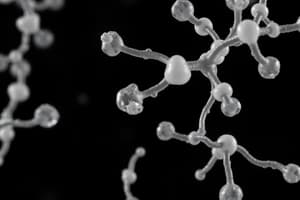Podcast
Questions and Answers
What color change is observed in Benedict's Test when reducing sugars are present?
What color change is observed in Benedict's Test when reducing sugars are present?
- Yellow to dark brown
- Blue to green, yellow, orange, or red (correct)
- Clear to cloudy purple
- Red to pink
What does a red precipitate in Barfoed's Test indicate?
What does a red precipitate in Barfoed's Test indicate?
- Presence of disaccharides
- Presence of monosaccharides (correct)
- Absence of sugars
- Presence of starch
Which of the following tests is used specifically to detect starch?
Which of the following tests is used specifically to detect starch?
- Molisch's Test
- Fehling's Test
- Tollen's Test
- Iodine Test (correct)
What indicates a positive result in Tollen's Test?
What indicates a positive result in Tollen's Test?
Which of the following identifies carbohydrates through color development from yellow to brown?
Which of the following identifies carbohydrates through color development from yellow to brown?
What functional group in carbohydrates can be identified using phenylhydrazine?
What functional group in carbohydrates can be identified using phenylhydrazine?
Which test can identify both aldoses and ketoses?
Which test can identify both aldoses and ketoses?
How can anomers of carbohydrates be distinguished?
How can anomers of carbohydrates be distinguished?
Flashcards are hidden until you start studying
Study Notes
Qualitative Analysis of Carbohydrates
Preliminary Tests
-
Benedict's Test:
- Detects reducing sugars (e.g., glucose, fructose).
- Reaction with copper(II) sulfate results in color change (blue to green, yellow, orange, or red).
-
Barfoed's Test:
- Differentiates between monosaccharides and disaccharides.
- Red precipitate indicates presence of monosaccharides after heating.
-
Molisch's Test:
- General test for carbohydrates.
- Formation of a purple ring with alpha-naphthol and concentrated sulfuric acid indicates carbohydrates.
Specific Tests for Reducing Sugars
-
Benedict's Test:
- As described in Preliminary Tests; confirms reducing sugars.
-
Fehling's Test:
- Similar to Benedict's, uses Fehling's A (copper(II) sulfate) and Fehling's B (alkaline tartrate).
- Red precipitate indicates reducing sugars.
-
Tollen's Test:
- Silver nitrate solution; reducing sugars reduce Ag+ to metallic silver.
- Formation of a silver mirror on the test tube indicates presence.
Qualitative Indicators
-
Iodine Test:
- Specific for starch; blue-black color indicates presence.
-
Phenol-sulfuric Acid Test:
- Detects all carbohydrates; color development indicates presence (yellow to brown).
Functional Group Identification
-
Alcohol Groups:
- Carbohydrates contain hydroxyl (-OH) groups; can be identified using reagents like phenylhydrazine.
-
Carbonyl Groups:
- Aldoses and ketoses can be identified through specific tests (Benedict's, Fehling's).
-
Ring Structure Identification:
- Anomers (alpha or beta forms) can be distinguished using specific reagents and NMR spectroscopy.
-
Fermentation Tests:
- Utilizes yeast or bacteria to identify fermentable sugars by the production of gas or acid.
Qualitative Analysis of Carbohydrates
Preliminary Tests
- Benedict's Test detects reducing sugars such as glucose and fructose through a color change from blue to green, yellow, orange, or red when reacting with copper(II) sulfate.
- Barfoed's Test differentiates between monosaccharides and disaccharides; heating leads to red precipitate indicating the presence of monosaccharides.
- Molisch's Test serves as a general test for carbohydrates; a purple ring forms when alpha-naphthol reacts with concentrated sulfuric acid, indicating carbohydrate presence.
Specific Tests for Reducing Sugars
- Benedict's Test is reiterated for confirming reducing sugars, mirroring preliminary test conditions.
- Fehling's Test uses two solutions (Fehling's A and B) to confirm reducing sugars, producing a red precipitate.
- Tollen's Test utilizes silver nitrate; reducing sugars catalyze the reduction of Ag+ to metallic silver, resulting in a distinctive silver mirror effect inside the test tube.
Qualitative Indicators
- Iodine Test is specific for starch; when starch is present, a blue-black color is produced.
- Phenol-sulfuric Acid Test detects all carbohydrates; color change from yellow to brown signifies carbohydrate presence.
Functional Group Identification
- Alcohol Groups in carbohydrates are characterized by hydroxyl (-OH) groups, identifiable via reagents like phenylhydrazine.
- Carbonyl Groups are associated with aldoses and ketoses, identifiable through tests like Benedict's and Fehling's.
- Ring Structure Identification enables differentiation of anomers (alpha or beta forms) via specific reagents and NMR spectroscopy.
- Fermentation Tests assess the presence of fermentable sugars by monitoring gas or acid production from yeast or bacteria.
Studying That Suits You
Use AI to generate personalized quizzes and flashcards to suit your learning preferences.




